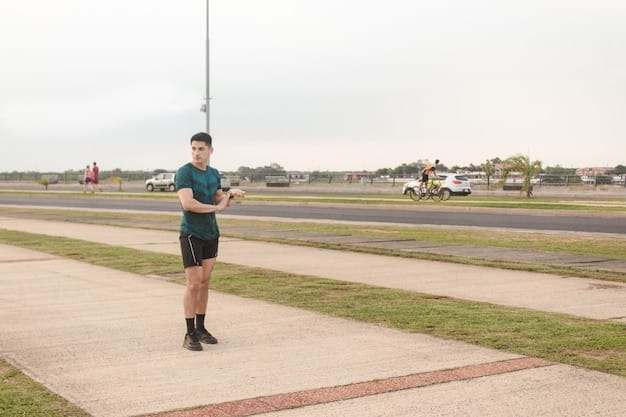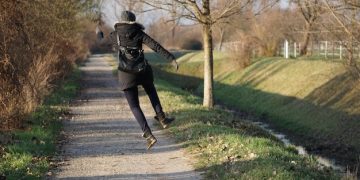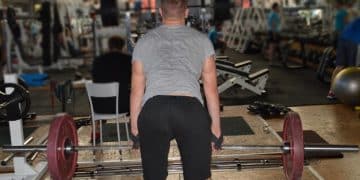Running Form Secrets: Boost Speed & Endurance by 20%

Running form secrets are crucial for athletes looking to enhance speed and endurance; optimizing posture, stride, and arm movement can lead to increased efficiency and a potential performance boost of up to 20%.
Do you want to unlock your full running potential? Discover the running form secrets: how to improve your speed and endurance by 20% through simple adjustments to your technique, and experience the difference efficient movement can make.
Understanding the Fundamentals of Efficient Running Form
Efficient running form isn’t just about looking good; it’s about maximizing your energy output and minimizing the risk of injury. Let’s begin by breaking down the core elements that contribute to a powerful and sustainable running style.
The Importance of Posture
Good posture is the keystone of efficient running. It allows for optimal breathing, reduces strain on your spine, and enables your muscles to work effectively.
Foot Strike and Cadence
Where and how your foot lands can significantly impact your speed and endurance. Optimizing your cadence—the number of steps you take per minute—can also lead to improvements.
- Maintain an Upright Posture: Keep your head up, shoulders relaxed, and core engaged.
- Aim for Midfoot Strike: Landing on your midfoot helps to absorb impact and propel you forward.
- Increase Your Cadence: A higher cadence (around 170-180 steps per minute) can reduce overstriding and improve efficiency.
By mastering these fundamentals, you can establish a foundation for improved speed and endurance. Focusing on posture and foot strike will lay the groundwork for more advanced running form adjustments.
Optimizing Your Stride Length for Speed and Endurance
Stride length is the distance you cover with each step. Finding the right balance between stride length and cadence is crucial for both speed and endurance. Let’s look at ways to ensure your stride is helping, not hindering, your progress.

Avoid Overstriding
Overstriding occurs when your foot lands too far in front of your body, acting as a brake and increasing the risk of injury.
Experiment with Different Stride Lengths
Adjusting your stride length allows you to find the best balance for your body and running style. Finding that equilibrium is key to unlocking more speed and stamina.
- Focus on Pushing Off: Concentrate on using your glutes and hamstrings to propel yourself forward.
- Shorten Your Stride: If you’re overstriding, consciously shorten your stride and increase your cadence.
- Gradual Adjustments: Make small changes to your stride length over time to allow your body to adapt.
Adjusting stride length is a delicate balance that requires practice and awareness. As you refine your stride, you’ll be better prepared to tackle longer distances and achieve faster times.
Harnessing the Power of Arm Swing in Running
Your arms play a surprisingly significant role in your running efficiency. Proper arm swing can improve balance, generate momentum, and contribute to overall speed. We’re going to discuss how to optimize your arm movements for peak efficiency.
Proper Arm Position
The position and movement of your arms can either help or hinder your running form. Proper positioning keeps you moving forward efficiently.
Coordinating Arm Movement with Leg Movement
Coordinating your arm and leg movements is essential for maintaining balance and generating power. Focus on a smooth, rhythmic swing to enhance coordination.
By focusing on arm position and coordinated movements, you can tap into an underutilized aspect of your running form. This will help you maximize your performance.
Breathing Techniques to Enhance Endurance by 20%
Proper breathing is essential for endurance. Efficient breathing techniques ensure that your muscles receive enough oxygen, allowing you to run further and faster.

Diaphragmatic Breathing
Diaphragmatic breathing, or belly breathing, allows you to take deeper, more efficient breaths, maximizing oxygen intake.
Coordinating Breathing with Stride
Synchronizing your breathing with your stride can help you maintain a steady rhythm and reduce fatigue.
- Inhale Deeply Through Your Nose and Mouth: Fill your lungs completely with each breath.
- Exhale Fully Through Your Mouth: Push out all the air from your lungs with each exhale.
- Coordinate Your Breathing: Try inhaling for three steps and exhaling for two steps to start.
By mastering these breathing techniques, you’ll be able to provide your body with the oxygen it needs to run stronger and longer. Incorporating these strategies into your routine will yield noticeable improvements in your endurance.
Strength Training Exercises to Support Running Form
Incorporate strength training exercises into your routine to support good running form. Strong muscles help maintain posture, generate power, and prevent injuries.
Core Strengthening Exercises
A strong core is essential for maintaining good posture and stability while running. Focus on exercises that target your abdominal, back, and hip muscles.
Lower Body Strengthening Exercises
Strong leg muscles are crucial for generating power and preventing injuries. Include exercises that target your quads, hamstrings, glutes, and calves.
- Planks: Strengthen your core to maintain proper posture.
- Squats: Build strength in your quads and glutes for a powerful stride.
- Lunges: Improve balance and stability while targeting your quads, hamstrings, and glutes.
By integrating these strength training exercises into your running routine, you’ll develop a stronger, more resilient body capable of maintaining excellent running form. Consistent training will lead to improved speed, endurance, and overall running performance.
Common Running Form Mistakes and How to Correct Them
Even experienced runners can fall into bad habits. Understanding common running form mistakes and how to correct them is crucial for preventing injuries and improving efficiency. Let’s look at some of the typical pitfalls and the steps you can take to avoid them.
Slouching Posture
Slouching can restrict breathing and strain your back. Keeping an upright posture is the best approach.
Heel Striking
Landing on your heel generates extra impact and can slow you down. Shift your foot strike to land on your midfoot.
- Focus on Posture: Imagine a string pulling you up from the crown of your head.
- Adjust Your Foot Strike: Consciously try to land on your midfoot with each step.
- Practice Regularly: Be mindful of your form during each run, and make adjustments as needed.
By recognizing and correcting these common running form mistakes, you can safeguard against injuries and realize untapped potential. Staying vigilant about your form will translate to a more efficient and enjoyable running experience.
| Key Point | Brief Description |
|---|---|
| 🏃 Upright Posture | Maintain a straight back and relaxed shoulders to boost efficiency. |
| 💨 Diaphragmatic Breathing | Breathe deeply using your diaphragm to maximize oxygen intake. |
| 💪 Core Strength | Strengthen your core to support posture and improve stability. |
| 🦶 Midfoot Strike | Aim to land on your midfoot to reduce impact and enhance propulsion. |
Frequently Asked Questions (FAQ)
▼
The ideal running cadence is often cited as around 170-180 steps per minute. However, this can vary based on individual factors like height and leg length. Focus on finding a cadence that feels natural and efficient for you.
▼
Arm swing is crucial for maintaining balance and generating momentum while running. Proper arm movement can improve your overall efficiency and coordination, contributing to better performance and reduced energy expenditure.
▼
Yes, strength training plays a vital role in supporting and enhancing running form. Strong muscles in your core, legs, and hips provide the necessary stability and power to maintain good posture and efficient movement patterns.
▼
Heel striking involves landing on your heel, which can increase impact and slow you down. In contrast, midfoot striking means landing on the middle of your foot, which helps absorb impact and allows for a smoother, more efficient stride.
▼
To correct overstriding, focus on shortening your stride length and increasing your cadence. Aim to land your foot underneath your hips, rather than extending your leg out in front of you. Regular practice can help adjust your form.
Conclusion
Mastering running form secrets: how to improve your speed and endurance by 20% is a journey that blends understanding, practice, and patience. By focusing on posture, stride length, arm swing, breathing techniques, and strength training, you can transform your running and achieve newfound levels of performance. So, lace up your shoes, pay attention to your body, and take each stride with purpose.





